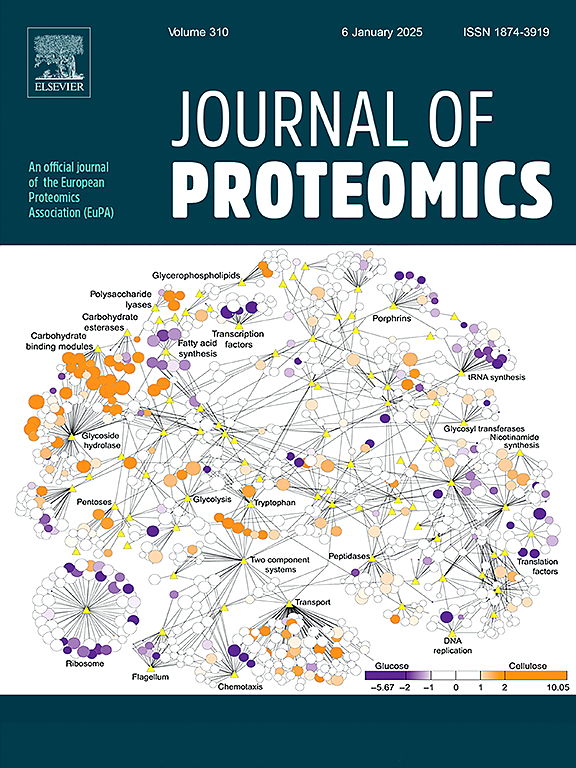优化了从单个患者来源的神经球获得个性化神经生物学见解的管道。
IF 2.8
2区 生物学
Q2 BIOCHEMICAL RESEARCH METHODS
引用次数: 0
摘要
该管道提供了一种从ipsc衍生的神经球中获得个性化神经生物学见解的精细方法。通过采用串联质量标签(TMT)标记,我们优化了样本池和多路复用,以便在不同的实验条件下进行稳健的比较分析,最大限度地提高每个样本的数据产量。通过单个患者来源的神经球(由神经祖细胞、早期神经元和放射状胶质细胞组成),本研究探索了蛋白质组学分析,以比传统的二维培养更准确地反映神经发育的细胞复杂性。鉴于其增强的相关性,这些3D神经球作为阐明神经发生、分化和神经病理机制的有价值模型,有助于体外神经模型的发展,减少对动物模型的依赖。意义:本研究评估了使用TMT 10-plex标记优化单个神经球蛋白质组学分析的十种蛋白质提取方案。它比较了成本、蛋白产量和检测差异表达蛋白的能力,确定了SPEED和S-Trap等方法对于高通量研究是有效的,而FASP在肽产量方面表现出色。TMT标记增强了蛋白质鉴定,特别是对低丰度蛋白质,并允许从有限的样品中进行预分选,以最大限度地分析。然而,诸如有限的PTM分析和次要蛋白质的潜在损失等挑战突出了基于特定研究目标选择方案的重要性。这项工作有助于优化体外神经模型的蛋白质组学工作流程,在对动物模型的依赖最小的情况下推进单细胞分析。本文章由计算机程序翻译,如有差异,请以英文原文为准。
Optimized pipeline for personalized neurobiological insights from single patient-derived Neurospheres
This pipeline presents a refined approach for deriving personalized neurobiological insights from iPSC-derived neurospheres. By employing Tandem Mass Tag (TMT) labeling, we optimized sample pooling and multiplexing for robust comparative analysis across experimental conditions, maximizing data yield per sample. Through single-patient-derived neurospheres—composed of neural progenitor cells, early neurons, and radial glia—this study explores proteomic profiling to mirror the cellular complexity of neurodevelopment more accurately than traditional 2D cultures. Given their enhanced relevance, these 3D neurospheres serve as a valuable model for elucidating neurogenesis, differentiation, and neuropathological mechanisms, contributing to the advancement of in vitro neural models and reducing dependency on animal models.
Significance
This study evaluates ten protein extraction protocols using TMT 10-plex labeling to optimize proteomic analysis from single neurospheres. It compares cost, protein yield, and the ability to detect differentially expressed proteins, identifying methods like SPEED and S-Trap as efficient for high-throughput studies, while FASP excels in peptide yield. TMT labeling enhances protein identification, particularly for low-abundance proteins, and allows pre-fractionation to maximize analysis from limited samples. However, challenges such as limited PTM analysis and the potential loss of minor proteins highlight the importance of selecting protocols based on specific research goals. This work contributes to optimizing proteomic workflows for in vitro neural models, advancing single-cell analysis with minimal reliance on animal models.
求助全文
通过发布文献求助,成功后即可免费获取论文全文。
去求助
来源期刊

Journal of proteomics
生物-生化研究方法
CiteScore
7.10
自引率
3.00%
发文量
227
审稿时长
73 days
期刊介绍:
Journal of Proteomics is aimed at protein scientists and analytical chemists in the field of proteomics, biomarker discovery, protein analytics, plant proteomics, microbial and animal proteomics, human studies, tissue imaging by mass spectrometry, non-conventional and non-model organism proteomics, and protein bioinformatics. The journal welcomes papers in new and upcoming areas such as metabolomics, genomics, systems biology, toxicogenomics, pharmacoproteomics.
Journal of Proteomics unifies both fundamental scientists and clinicians, and includes translational research. Suggestions for reviews, webinars and thematic issues are welcome.
 求助内容:
求助内容: 应助结果提醒方式:
应助结果提醒方式:


